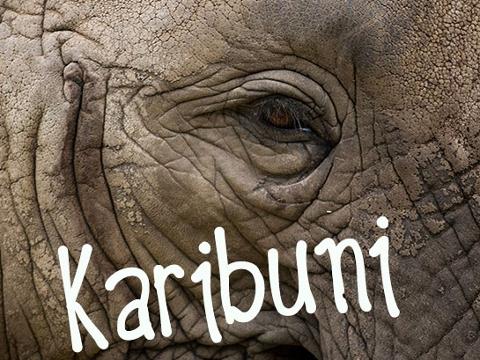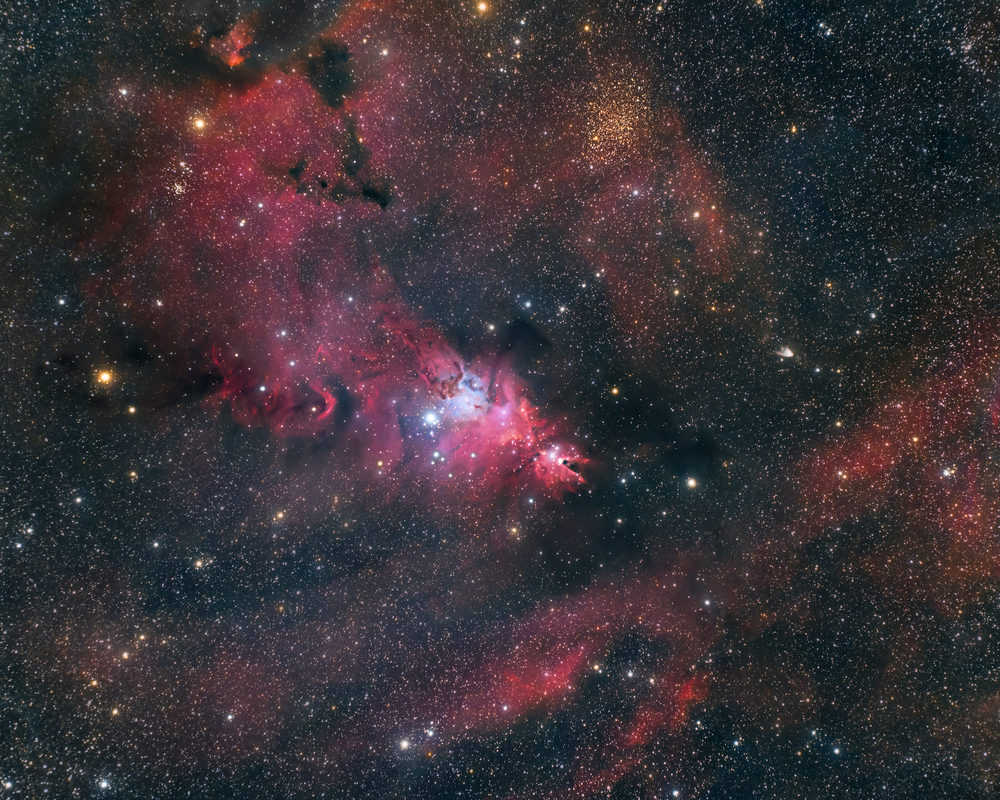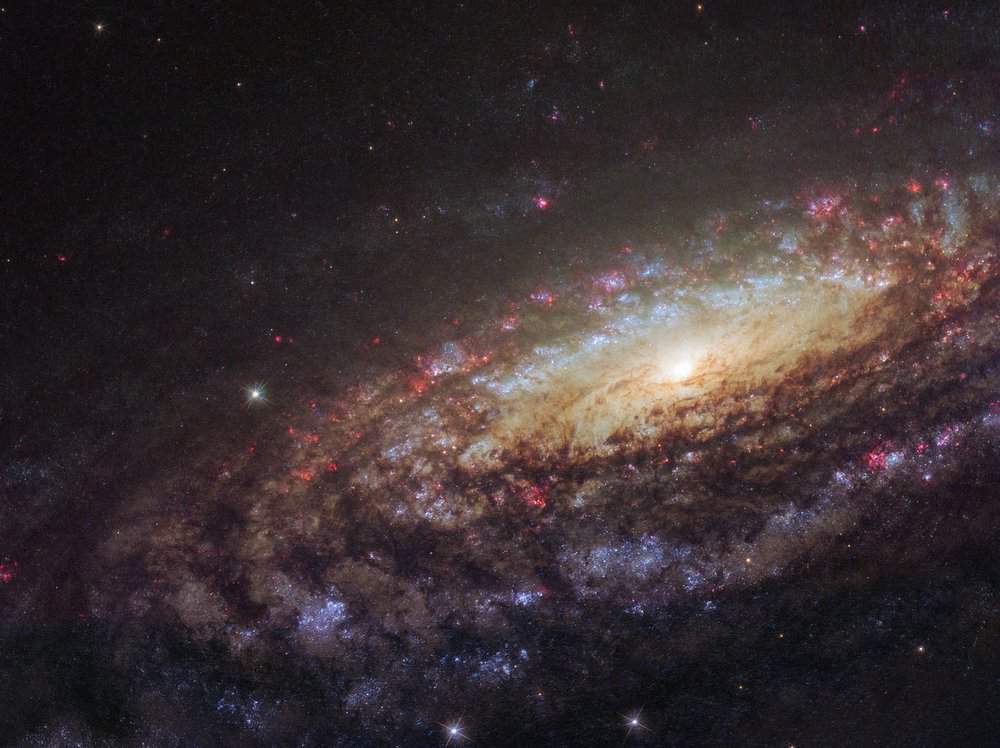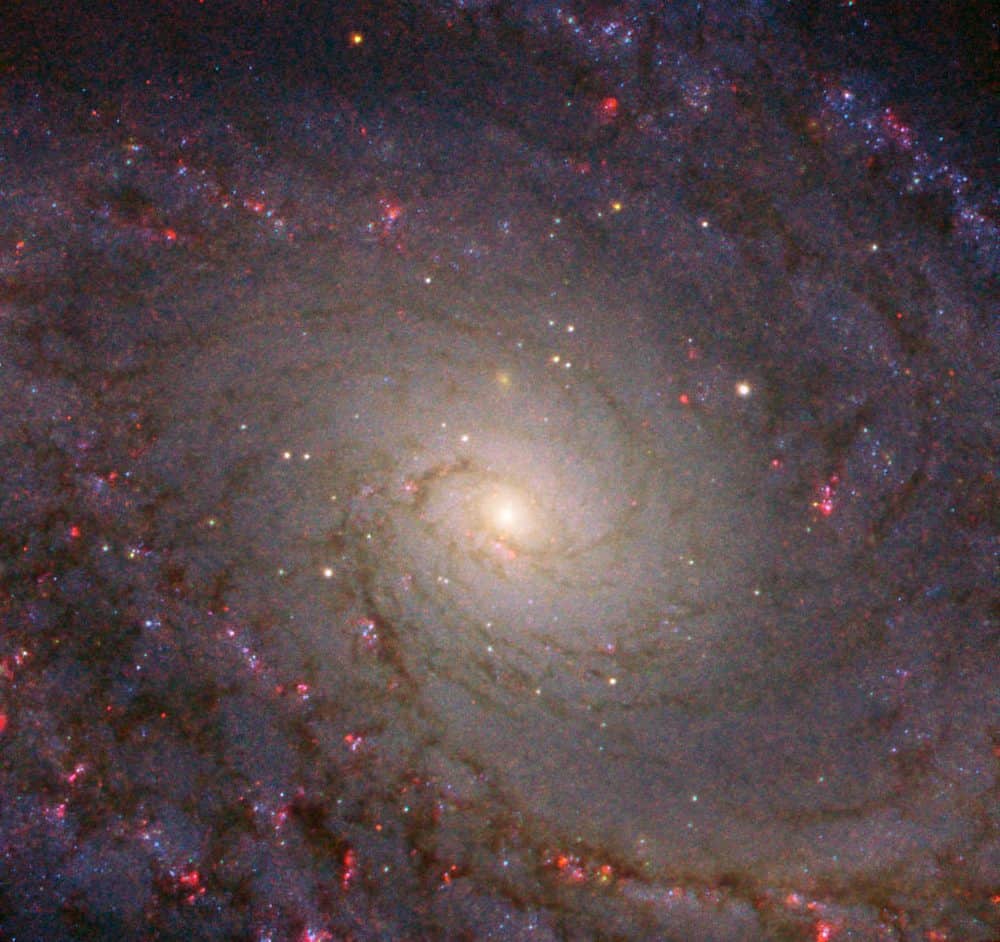Blog
Performing Monday 2-10-2020
Capitol Hill Magnet School in St Paul 1015 & 1130am
with Joe Shalita, Bingo Sei Kpolar & mick laBriola

Interstellar clouds of hydrogen gas and dust abound in this gorgeous skyscape. The 3 degree wide field of view stretches through the faint but fanciful constellation Monoceros, the Unicorn. A star forming region cataloged as NGC 2264 is centered, a complex jumble of cosmic gas, dust and stars about 2,700 light-years distant. It mixes reddish emission nebulae excited by energetic light from newborn stars with dark dust clouds. Where the otherwise obscuring dust clouds lie close to hot, young stars they also reflect starlight, forming blue reflection nebulae. A few light-years across, a simple sculpted shape known as the Cone Nebula is near center. Outlined by the red glow of hydrogen gas, the cone points toward the left and bright, blue-white S Monocerotis. Itself a multiple system of massive, hot stars S Mon is adjacent to bluish reflection nebulae and the convoluted Fox Fur nebula. Expansive dark markings on the sky are silhouetted by a larger region of fainter emission with yellowish open star cluster Trumpler 5 near the top of the frame. The curious compact cometary shape right of center is known as Hubble’s Variable Nebula.

Tom Rush (born February 8, 1941) is an American folk and blues singer and songwriter.
Rush was born in Portsmouth, New Hampshire, United States, the son of a teacher at St. Paul’s School, in Concord, New Hampshire. He began performing in 1961 while studying at Harvard University, after having graduated from the Groton School. He majored in English literature. Many of his early recordings are versions of Lowland Scots and Appalachian folk songs. He regularly performed at the Club 47 coffeehouse (now called Club Passim) in Cambridge, the Unicorn in Boston, and The Main Point in Bryn Mawr, Pennsylvania. In the 1970s he lived in Deering, New Hampshire.
Rush is credited by Rolling Stone magazine with ushering in the era of the singer-songwriter. In addition to performing his own compositions, he sang songs by Joni Mitchell, Jackson Browne, James Taylor, Murray McLauchlan, David Wiffen and William Hawkins, helping them to gain recognition early in their careers.
His 1968 composition “No Regrets” has become a standard, with numerous cover versions having been recorded (Rush did two radically different versions himself). These include The Walker Brothers, who gave Tom Rush Top Ten credit as a songwriter on the UK Singles Chart, Emmylou Harris, who included the song on her 1988 album Bluebird, and Midge Ure whose cover also made the UK Top Ten.
https://www.youtube.com/watch?v=SZMugRH-Jhc
more...Eddie Locke (August 2, 1930 – September 7, 2009) was an American jazz drummer.
Eddie Locke was a part of the fertile and vibrant Detroit jazz scene during the 1940s and 1950s, which brought forth many great musicians including the Jones brothers (Hank, Thad, and Elvin), Kenny Burrell, Lucky Thompson, Tommy Flanagan, Barry Harris, and so many others. He eventually formed a variety act with drummer Oliver Jackson called Bop & Locke which played the Apollo Theater. He moved to New York City in 1954, and worked there with Dick Wellstood, Tony Parenti, Red Allen, Willie “The Lion” Smith, and Teddy Wilson amongst others. During this time he came under the tutelage of the great Jo Jones, and eventually became known as a driving and swinging drummer who kept solid time and supported the soloist. During the late 1950s he formed two of his most fruitful musical relationships, one with Roy Eldridge, and the other with Coleman Hawkins. His recording debut came with Eldridge in 1959 on “On The Town”. He later became a member of the Coleman Hawkins Quartet in the 1960s along with pianist Tommy Flanagan and bassist Major Holley. That group made many fine records including the exquisite album “Today and Now”, in 1963. Throughout the 1970s, he played with Roy Eldridge at Jimmy Ryan’s in Manhattan, and wound out his career freelancing, as well as teaching youngsters at the Trevor Day School on Manhattan’s upper west side.
more...Fatma Ahmed Kamal Shaker (Arabic: فاطمة أحمد كمال شاكر), better known by her stage name Shadia (Arabic: شادية, Shādiyya; 8 February 1931 – 28 November 2017), was an Egyptian actress and singer. She was famous for her roles in light comedies and drama in the 1950s and 1960s. She is one of the iconic actresses and singers in Egypt and the middle east region and a symbol of the golden age of Egyptian Cinema. Her movies and songs are greatly influential in the Egyptian and the Arabic cultures. Critics consider her the most important and successful comprehensive Egyptian and Arabic artist of all time. Her first appearance in a film was in Azhar wa Ashwak (Flowers and Thorns), and her last film was La Tas’alni Man Ana (Don’t Ask Me Who I Am). She is also known for her patriotic song “Ya Habibti Ya Masr” (Oh Egypt, My Love) and her breakthrough leading role in the Egyptian movie “Al Maraa Al Maghoula” (The Unknown Woman). Six of her movies are listed in the top 100 Egyptian movies of the 20th century. In April 2015, she became the first actress to be awarded an honorary doctorate by the Academy of Arts (Egypt). She was given the nickname “Idol of the Masses” following her successful movie “Maaboudat El Gamaheer” (Idol of the Masses). Other notable nicknames include “The Guitar of the Arabic Singing” (Egyptian Arabic: قيثارة الغناء العربى) and “The Golden Guitar” (Egyptian Arabic: القيثارة الذهبية).
more...Floyd Dixon (February 8, 1929 – July 26, 2006) was an American rhythm-and-blues pianist and singer.
Dixon was born in Marshall, Texas. Some sources give his birth name as Jay Riggins, Jr., although he himself stated that Floyd Dixon was his real name and that his parents were Velma and Ford Dixon. Growing up, he was influenced by blues, gospel, jazz and country music. His family moved to Los Angeles, California, in 1942. There Dixon met Charles Brown, who had an influence on his music.
The self-dubbed “Mr. Magnificent”, Dixon signed a recording contract with Modern Records in 1949, specializing in jump blues and sexualized songs like “Red Cherries”, “Wine Wine Wine”, “Too Much Jelly Roll” and “Baby Let’s Go Down to the Woods”. Both “Dallas Blues” and “Mississippi Blues”, credited to the Floyd Dixon Trio, reached the Billboard R&B chart in 1949, as did “Sad Journey Blues”, issued by Peacock Records in 1950.
Dixon replaced Charles Brown on piano and vocals in the band Johnny Moore’s Three Blazers in 1950, when Brown departed to start a solo career. The group recorded for Aladdin Records and reached the R&B chart with “Telephone Blues” (credited to Floyd Dixon with Johnny Moore’s Three Blazers). Staying with the record label, Dixon had a small hit under his own name in 1952 with “Call Operator 210”. He switched to Specialty Records in 1952 and to Cat Records, a subsidiary of Atlantic Records in 1954. “Hey Bartender” (later covered by the Blues Brothers) and “Hole in the Wall” were released during this time.
In the 1970s Dixon left the music industry for a quieter life in Texas, though he did occasional tours in the 1970s and 1980s. In 1984 he was commissioned to write “Olympic Blues” for the 1984 Summer Olympics.
more...Alonzo “Lonnie” Johnson (February 8, 1899 – June 16, 1970) was an American blues and jazz singer, guitarist, violinist and songwriter. He was a pioneer of jazz guitar and jazz violin and is recognized as the first to play an electrically amplified violin.
Johnson was born in New Orleans, Louisiana, and raised in a family of musicians. He studied violin, piano and guitar as a child and learned to play various other instruments, including the mandolin, but he concentrated on the guitar throughout his professional career. “There was music all around us,” he recalled, “and in my family you’d better play something, even if you just banged on a tin can.”
Johnson pioneered the single-string solo guitar styles that have become customary in modern rock, blues and jazz music.
By his late teens, he was playing guitar and violin in his father’s family band at banquets and weddings, alongside his brother James “Steady Roll” Johnson. He also worked with the jazz trumpeter Punch Miller in the Storyville district of New Orleans.
In 1917, Johnson joined a revue that toured England, returning home in 1919 to find that all of his family, except his brother James, had died in the 1918 influenza epidemic.
https://www.youtube.com/watch?v=ePPHj5Ujo0Q
more...https://www.youtube.com/watch?v=zffx_et6T3c
more...This NASA/ESA Hubble Space Telescope image shows a spiral galaxy known as NGC 7331. First spotted by the prolific galaxy hunter William Herschel in 1784, NGC 7331 is located about 45 million light-years away in the constellation of Pegasus (The Winged Horse). Facing us partially edge-on, the galaxy showcases it’s beautiful arms which swirl like a whirlpool around its bright central region. Astronomers took this image using Hubble’s Wide Field Camera 3 (WFC3), as they were observing an extraordinary exploding star — a supernova — which can still be faintly seen as a tiny red dot near the galaxy’s central yellow core. Named SN2014C, it rapidly evolved from a supernova containing very little Hydrogen to one that is Hydrogen-rich — in just one year. This rarely observed metamorphosis was luminous at high energies and provides unique insight into the poorly understood final phases of massive stars. NGC 7331 is similar in size, shape, and mass to the Milky Way. It also has a comparable star formation rate, hosts a similar number of stars, has a central supermassive black hole and comparable spiral arms. The primary difference between our galaxies is that NGC 7331 is an unbarred spiral galaxy — it lacks a “bar” of stars, gas and dust cutting through its nucleus, as we see in the Milky Way. Its central bulge also displays a quirky and unusual rotation pattern, spinning in the opposite direction to the galactic disc itself. By studying similar galaxies we hold a scientific mirror up to our own, allowing us to build a better understanding of our galactic environment which we cannot always observe, and of galactic behaviour and evolution as a whole.

Curtis Ousley (born Curtis Montgomery; February 7, 1934 – August 13, 1971), who performed under the stage name King Curtis, was an American saxophonist known for rhythm and blues, rock and roll, soul, blues, funk and soul jazz. Variously a bandleader, band member, and session musician, he was also a musical director and record producer. Adept at tenor, alto, and soprano saxophone, he played riffs and solos on such hit singles as “Respect” by Aretha Franklin, and “Yakety Yak” by The Coasters (the latter of which later became the inspiration for Boots Randolph‘s “Yakety Sax“) and his own “Memphis Soul Stew”.
Curtis Montgomery was born in Fort Worth, Texas, the son of Ethel Montgomery, and was adopted, with his sister Josephine Allen (died 2019), by Josie and William Ousley. Curtis attended I.M. Terrell High School, and studied and performed music with schoolmate Ornette Coleman.
Curtis started playing saxophone at the age of twelve in the Fort Worth area. He took interest in many musical genres including jazz, rhythm and blues, and popular music. As a student pursuing music, he turned down college scholarships in order to join the Lionel Hampton Band. During his time with Hampton, he was able to write and arrange music and learn guitar. In 1952 Curtis decided to move to New York and became a session musician, recording for such labels as Prestige, Enjoy, Capitol, and Atco. He recorded with Nat Adderley, Wynton Kelly, Buddy Holly, Waylon Jennings and Andy Williams.
Stylistically, Curtis took inspiration from saxophonists Lester Young, Louis Jordan, Illinois Jacquet, Earl Bostic, and Gene Ammons. Known for his syncopated and percussive style, he was both versatile and powerful as a musician. He put together a group during his time as a session musician that included Richard Tee, Cornell Dupree, Jerry Jemmott, and Bernard Purdie.
more...Earl Silas Johnson IV (February 7, 1934 – April 17, 2003), known as Earl King, was an American singer, guitarist, and songwriter, most active in blues music. A composer of blues standards such as “Come On” (covered by Jimi Hendrix, Freddy King, Stevie Ray Vaughan) and “Big Chief” (recorded by Professor Longhair), he was an important figure in New Orleans R&B.
King was born in New Orleans, Louisiana, United States. His father was a piano player. He died when Earl was still a baby, and Earl was brought up by his mother. With his mother, he started going to church at an early age. In his youth he sang gospel music, but he took the advice of a friend to switch to blues to make a better living.
King started to play the guitar at the age of 15. Soon he started entering talent contests at local clubs, including the Dew Drop Inn. At one such club he met his idol, Guitar Slim. King started imitating Slim, and his presence had a big impact on his musical direction. In 1954, Slim was injured in an automobile accident (right around the time he had the number 1 R&B hit “The Things That I Used To Do”), and King was deputized to continue a tour with Slim’s band, representing himself as Slim. After succeeding in this role, King became a regular at the Dew Drop Inn.
His first recording was made in 1953. As Earl Johnson, he released a 78-rpm record, “Have You Gone Crazy”/”Begging at Your Mercy”, for Savoy Records. The following year, the talent scout Johnny Vincent introduced King to Specialty Records, for which he recorded some sides, including “Mother’s Love”, which was locally popular. In 1955, King signed with Vincent’s label, Ace. His first single for that label, “Those Lonely, Lonely Nights”, was a hit, reaching number 7 on the Billboard R&B chart. He continued to record for Ace for the next five years. During that time, he also he started writing songs for other artists, such as Roland Stone and Jimmy Clanton.
more...James Hubert “Eubie” Blake (February 7, 1887 – February 12, 1983), was an American composer, lyricist, and pianist of ragtime, jazz, and popular music. In 1921, he and his long-time collaborator Noble Sissle wrote Shuffle Along, one of the first Broadway musicals to be written and directed by African Americans. Blake’s compositions included such hits as “Bandana Days”, “Charleston Rag”, “Love Will Find a Way”, “Memories of You” and “I’m Just Wild About Harry“. The musical Eubie!, which opened on Broadway in 1978, featured his works. Blake was born February 7, 1887, at 319 Forrest Street, in Baltimore, Maryland. Of the eight children of former slaves Emily “Emma” Johnstone (1861–1927) and John Sumner Blake (1838–1917), he was the only one to survive infancy.
Blake’s musical training began when he was four or five years old. While out shopping with his mother, he wandered into a music store, climbed on the bench of an organ, and started “foolin’ around”. When his mother found him, the store manager said to her, “The child is a genius! It would be criminal to deprive him of the chance to make use of such a sublime, God-given talent.” The Blakes purchased a pump organ for US$75.00, making payments of 25 cents a week. When Blake was seven, he received music lessons from a neighbor, Margaret Marshall, an organist for the Methodist church. At age 15, without his parents’ knowledge, he began playing piano at Aggie Shelton’s Baltimore bordello. Blake got his first big break in the music business in 1907, when the world champion boxer Joe Gans hired him to play the piano at Gans’s Goldfield Hotel, the first “black and tan club” in Baltimore. Blake played at the Goldfield during the winters from 1907-1914, spending his summers playing clubs in Atlantic City. During this period, he also studied composition in Baltimore with Llewellyn Wilson.
It is played at about 240 beats per minute, most commonly in an A-phrygian mode, with a sharpened third to make A major the root chord. A typical rasgueado (a strumming pattern that sets the rhythm) involves only the A and B♭ chords as follows:
This eye-catching galaxy is known as NGC 5364. The late-type normal spiral galaxy NGC 5364 is located at a distance of 57 million light-years.
Unmistakably a spiral, NGC 5364 is also something known as a grand design spiral galaxy — a descriptive name deserved by only one-tenth of spirals. While all spirals have a structure that is broadly similar, there is quite a bit of variation amongst individual galaxies; some have patchy, oddly-shaped arms, some have bars of stars cutting through their core, some are colossal and radiant, and others are dim and diminutive. Grand designs like NGC 5364 are in many ways the archetype of a spiral galaxy. They are characterized by their prominent, well-defined arms, which circle outwards from a clear core.
Despite being classified in this way, NGC 5364 is far from perfect. Its arms are asymmetrical compared to other grand design spirals — this is thought to be due to interactions with a nearby neighbor. This neighbor and NGC 5364 are tugging on one another, warping and moving their stars and gas around and causing this misshapen appearance.

Natalie Maria Cole (February 6, 1950 – December 31, 2015) was an American singer, songwriter, and actress. Cole was the daughter of American singer and jazz pianist Nat King Cole. She rose to success in the mid-1970s as an R&B singer with the hits “This Will Be“, “Inseparable” (1975), and “Our Love” (1977). She returned as a pop singer on the 1987 album Everlasting and her cover of Bruce Springsteen‘s “Pink Cadillac“. In the 1990s, she sang traditional pop by her father, resulting in her biggest success, Unforgettable… with Love, which sold over seven million copies and won her seven Grammy Awards. She sold over 30 million records worldwide. On December 31, 2015, Cole died at the age of 65 at Cedars-Sinai Medical Center in Los Angeles, California, due to congestive heart failure.
Natalie Cole was born at Cedars of Lebanon Hospital in Los Angeles, to American singer and jazz pianist Nat King Cole and former Duke EllingtonOrchestra singer Maria Hawkins Ellington, and raised in the affluent Hancock Park district of Los Angeles. Regarding her childhood, Cole referred to her family as “the black Kennedys” and was exposed to many great singers of jazz, soul and blues. At the age of 6, Natalie sang on her father’s Christmas album The Magic of Christmas and later started performing at age 11.
more...Robert Nesta Marley, OM (6 February 1945 – 11 May 1981) was a Jamaican singer and songwriter. Considered one of the pioneers of reggae, his musical career was marked by blending elements of reggae, ska, and rocksteady, as well as forging a smooth and distinctive vocal and songwriting style. Marley’s contributions to music increased the visibility of Jamaican music worldwide, and made him a global figure in popular culture for over a decade. Over the course of his career Marley became known as a Rastafari icon, and the singer sought to infuse his music with a sense of spirituality. He is also considered a global symbol of Jamaican culture and identity, and was controversial in his outspoken support for the legalization of marijuana, while he also advocated for Pan-Africanism.
Born in Nine Mile, British Jamaica, Marley began his professional musical career in 1963, after forming Bob Marley and the Wailers. The group released its debut studio album The Wailing Wailers in 1965, which contained the single “One Love/People Get Ready“; the song was immensely popular, peaking in the top five on worldwide music charts, and established the group as a rising figure in reggae. The Wailers subsequently released eleven further studio albums; while initially employing louder instrumentation and singing, the group began engaging in rhythmic-based song construction in the late 1960s and early 1970s, which coincided with the singer’s conversion to Rastafarianism. During this period Marley relocated to London, and the group typified their musical shift with the release of the album The Best of The Wailers (1971).
The group attained international success after the release of the albums Catch a Fire and Burnin’ (both 1973), and forged a reputation as touring artists. A year later the Wailers disbanded, and Marley went on to release his solo material under the band’s name.[10] His debut studio album Natty Dread (1974) received positive reception, as did its follow-up Rastaman Vibration (1976). A few months after the album’s release Marley survived an assassination attempt at his home in Jamaica, which prompted him to permanently relocate to London soon afterward. There he recorded the album Exodus (1977); it incorporated elements of blues, soul, and British rock, enjoyed widespread commercial success, and is widely considered one of the best albums of all time.
In 1977, Marley was diagnosed with acral lentiginous melanoma; he died as a result of the illness in 1981. His fans around the world expressed their grief, and he received a state funeral in Jamaica. The greatest hits album Legend was released in 1984, and subsequently became the best-selling reggae album of all-time. Marley also ranks as one of the best-selling music artists of all-time, with estimated sales of more than 75 million records worldwide, while his sound and style have influenced artists of various genres. He was posthumously honored by Jamaica soon after his death, as he was designated the nation’s Order of Merit award.
https://www.youtube.com/watch?v=imfiY8ZVZ0g
more...More Posts
- Big John Patton Day
- Paul Gonsalves Day
- World Music with Martá Sebestyén
- Daily Roots with Prince Buster
- The Cosmos with R Aquarii
- Tomasz Stanko Day
- Clyde Bernhardt Day
- World Music with Diali Cissokho & Kaira Ba
- Daily Roots with Linval Thompson
- The Cosmos with NGC 3576
- Bela Fleck Day
- Lee Morgan Day
- Blind Boy Fuller Day
- World Music with Omar Bashir
- Daily Roots with Owen Gray
- The Cosmos with NGC 6300
- Mitch Mitchell Day
- Colin Bailey Day
- World Music with Combo Ginebra
- Daily Roots with Freddie McGregor